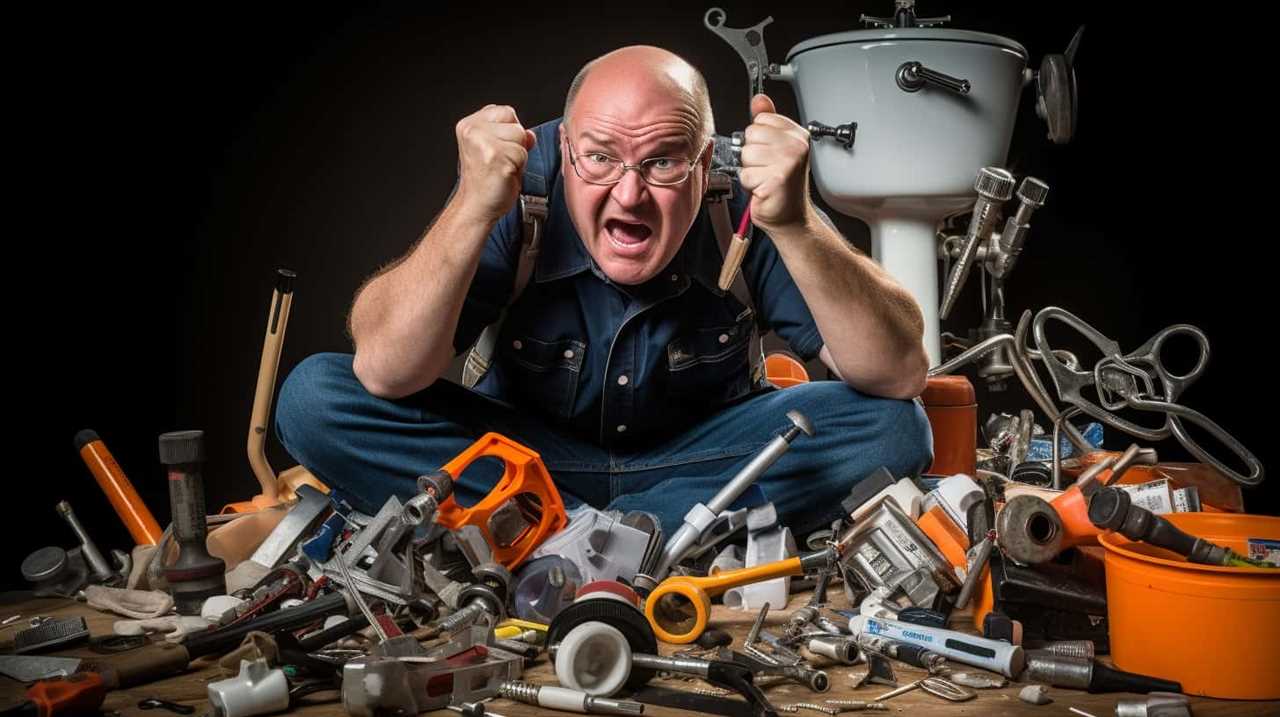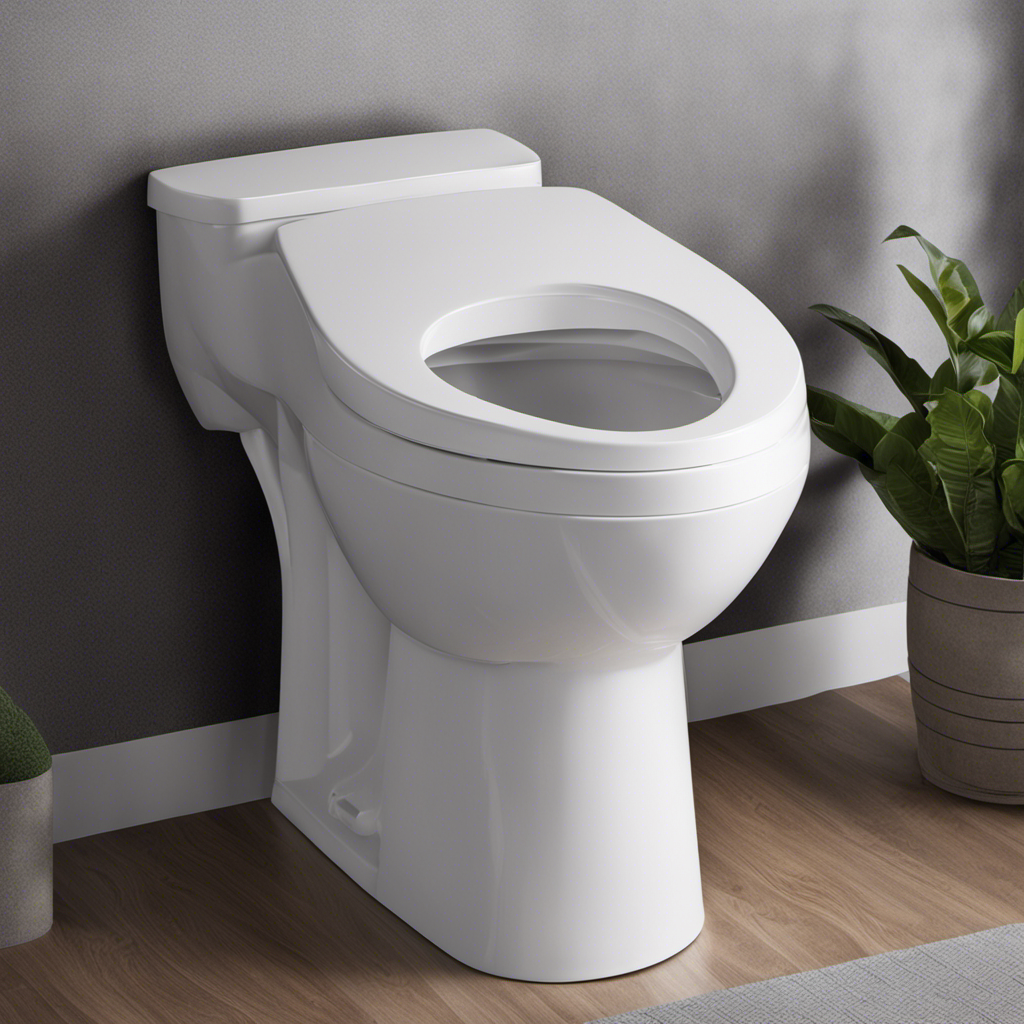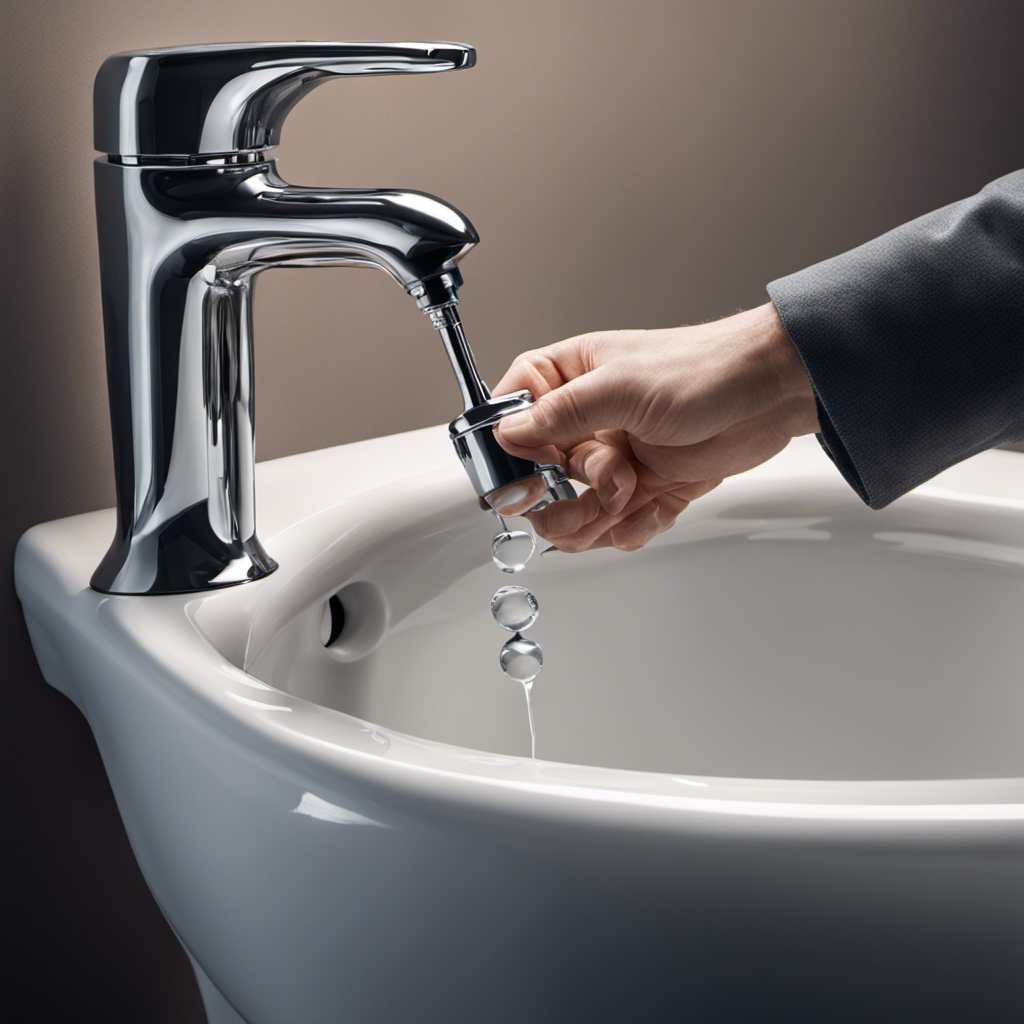Are you fed up with uninspiring toilet flushes?
Well, we’ve got good news – we’ve cracked the code to achieving a better flush!
In this article, we’ll share our expertise on simple yet effective techniques that can elevate your flushing game.
From adjusting the flapper chain to upgrading your toilet’s flush valve, we’ll guide you through the steps to ensure a powerful and efficient flush every time.
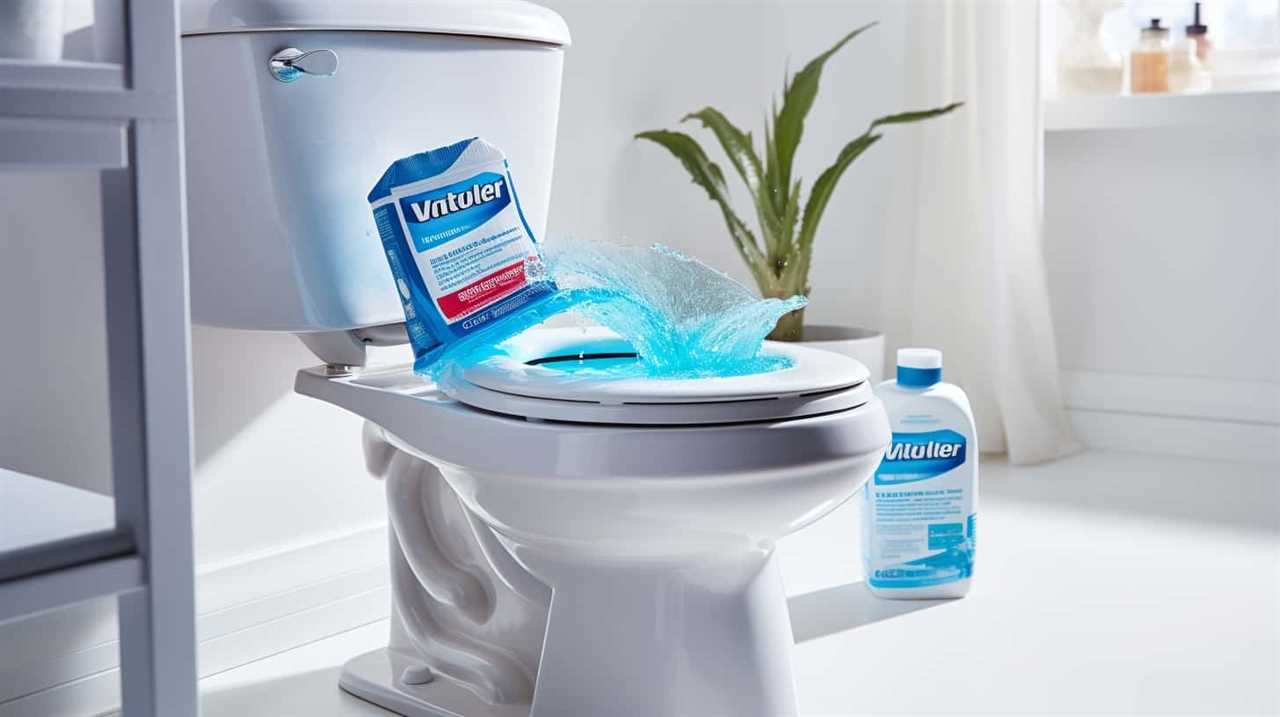
Get ready to master the art of flushing like a pro!
Key Takeaways
- Regularly check and adjust the water level in the toilet tank to ensure flush efficiency.
- Clean and maintain the jets to prevent clogs and maintain optimal flushing performance.
- Use a vinegar-water mixture to remove mineral deposits from the jets and brush away debris accumulation.
- Consider using a plunger with a flange or bell-shaped end to improve toilet flush performance, and seek professional help for complex flushing problems.
Check the Water Level
To improve the flush of a toilet, we should regularly check the water level using a simple method. Start by removing the tank lid and observing the water level. It should be approximately one inch below the overflow pipe. If the water level is too high or too low, it can affect the efficiency of the flush.
Next, check the float, which is responsible for regulating the water level. Ensure that it isn’t sticking or obstructed in any way. If necessary, adjust the float arm or bend it slightly to achieve the desired water level.
Additionally, inspect the flapper, which is responsible for releasing the water into the bowl during a flush. Make sure it isn’t worn out or damaged.
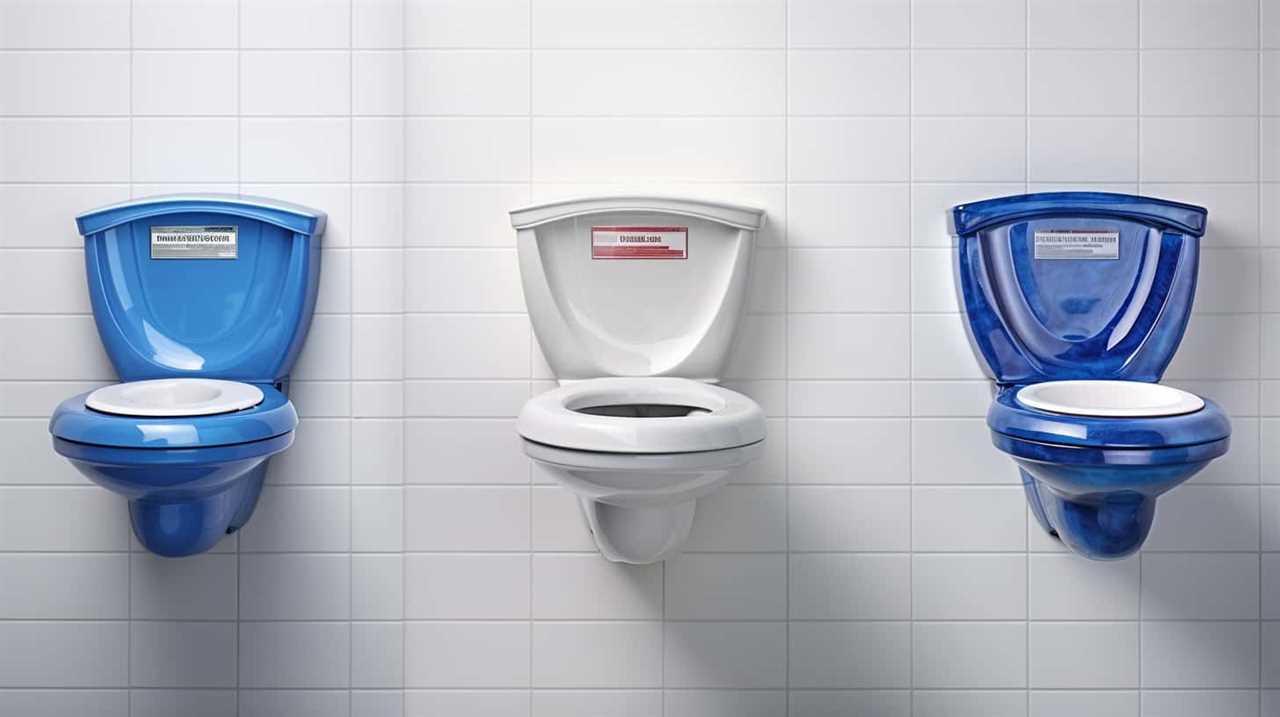
Adjust the Flapper Chain
To adjust the flapper chain and improve the flush of a toilet, we need to ensure it’s properly connected and not too loose or tight. Here are four steps to adjust the flapper chain effectively:
- Locate the flapper chain: The flapper chain connects the flapper to the toilet handle. It should have a little slack but not be too loose.
- Adjust the chain length: If the chain is too loose, it may not lift the flapper properly. If it’s too tight, it can prevent the flapper from closing completely. Adjust the chain length by moving the hook on the chain to a different hole.
- Test the flush: After adjusting the chain, flush the toilet to check if the flapper opens fully and closes tightly. If not, make further adjustments until it works properly.
- Consider alternative unclogging methods: If adjusting the flapper chain doesn’t improve the flush, you may need to explore other options like jet cleaning techniques to remove any clogs or obstructions in the toilet’s plumbing system.
Clean the Jets
When it comes to improving the flush efficiency of a toilet, one important step is to clean the jets. The jets are responsible for directing water into the bowl, creating the necessary force for a powerful flush.
Over time, these jets can become clogged with mineral deposits, debris, or other blockages, reducing their effectiveness.
Jet Cleaning Techniques
We regularly maintain our toilets by using jet cleaning techniques to keep the jets clean and functioning efficiently. Keeping the jets clean is crucial for optimal flushing performance and preventing clogs.
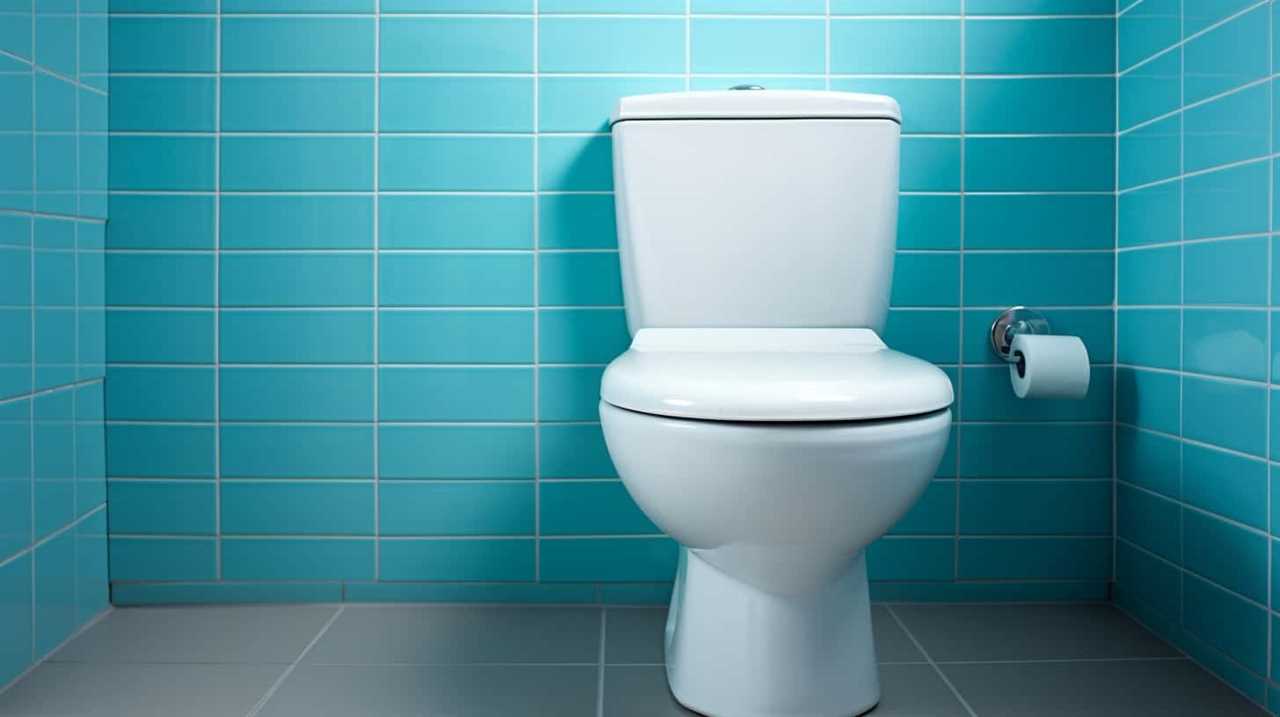
Here are four effective jet cleaning techniques to ensure your toilet flushes better:
- Jet cleaning products: Invest in high-quality jet cleaning products specifically designed for toilets. These products contain powerful ingredients that break down and remove mineral deposits, limescale, and other buildup from the jets.
- Regular maintenance: Regularly clean the jets to prevent blockages and maintain optimal water flow. This includes removing any debris or sediment that may accumulate over time.
- Deep cleaning: Occasionally, perform a deep cleaning of the jets to remove stubborn buildup. You can use a toilet brush or a jet cleaning tool to scrub the jets thoroughly.
- Professional assistance: If you’re unsure about cleaning the jets yourself or notice persistent issues with flushing, consider hiring a professional plumber. They’ve the expertise and specialized tools to clean the jets effectively.
Improving Flush Efficiency
To ensure optimal flushing performance and prevent clogs, it’s important to maintain clean and efficient jets in your toilet. The jets are responsible for directing water into the bowl during flushing, and if they become clogged or inefficient, it can result in weak or incomplete flushes.
One way to improve flush efficiency is by cleaning the jets regularly. Start by turning off the water supply and flushing the toilet to drain the tank. Remove the tank lid and locate the jets, which are usually found underneath the rim of the toilet bowl. Use a brush and a mixture of vinegar and water to scrub away any mineral deposits or debris that may be blocking the jets.
Additionally, adjusting the fill valve can also help improve flush efficiency. If you’re experiencing flush noise or weak flushes, it may be due to an improperly adjusted fill valve. By adjusting the water level to the recommended height, you can ensure a proper flush every time.
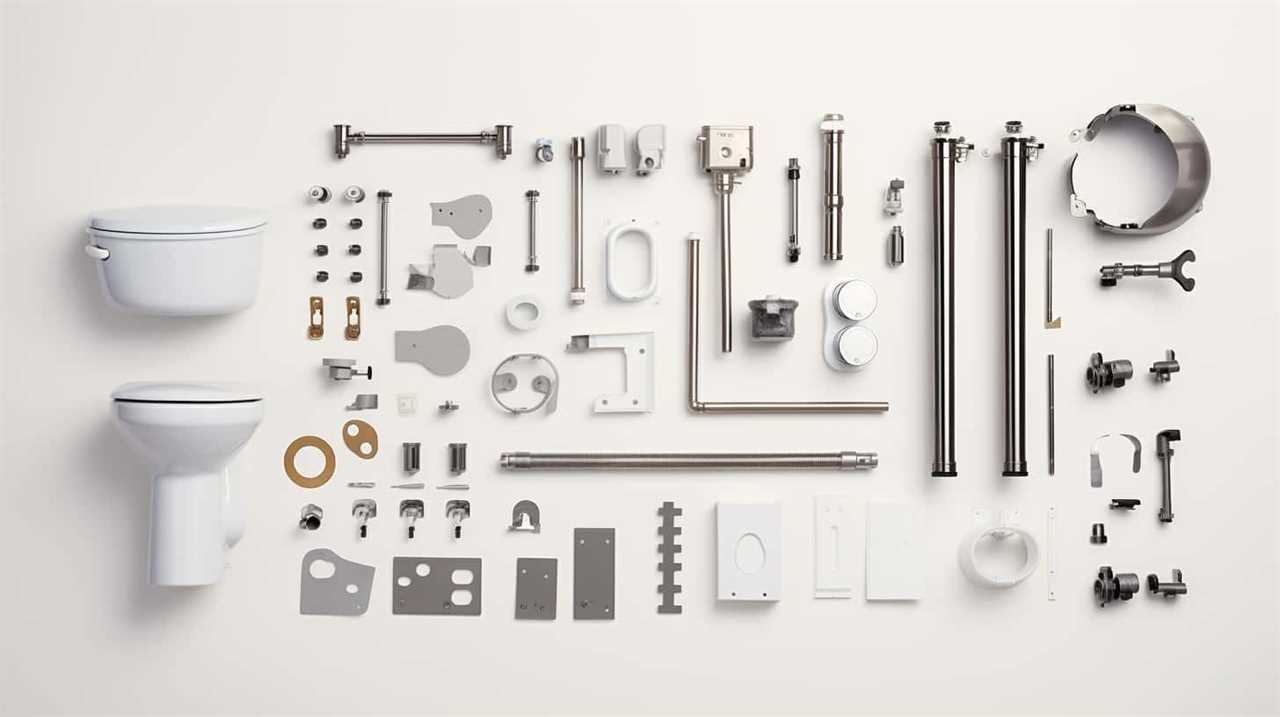
Troubleshooting flush noise can be done by checking the fill valve for any loose or worn parts. Tighten or replace any faulty components to eliminate the noise and improve flush efficiency.
Common Jet Blockages
To ensure optimal flush performance, it’s important to regularly clean the jets, which are responsible for directing water into the toilet bowl. Neglecting to clean the jets can lead to blockages, causing inefficient flushing and potential clogs.
Here are four common causes of jet blockages and troubleshooting tips to address them:
- Mineral deposits: Over time, minerals in the water can build up and clog the jets. To remove these deposits, use a mixture of vinegar and water to soak the jets overnight, then scrub gently with a brush.
- Debris accumulation: Dirt, hair, and other debris can accumulate in the jets, obstructing water flow. Use a small brush or toothbrush to dislodge and remove any debris.
- Hard water scaling: Hard water can cause scaling on the jets, reducing their effectiveness. Use a descaling agent specifically designed for toilets to remove the buildup.
- Faulty flapper: A worn or misaligned flapper can disrupt the flow of water into the jets. Check the flapper for any signs of damage or misalignment and replace if necessary.
By addressing these common causes of jet blockages, you can ensure a more efficient and effective flushing experience.
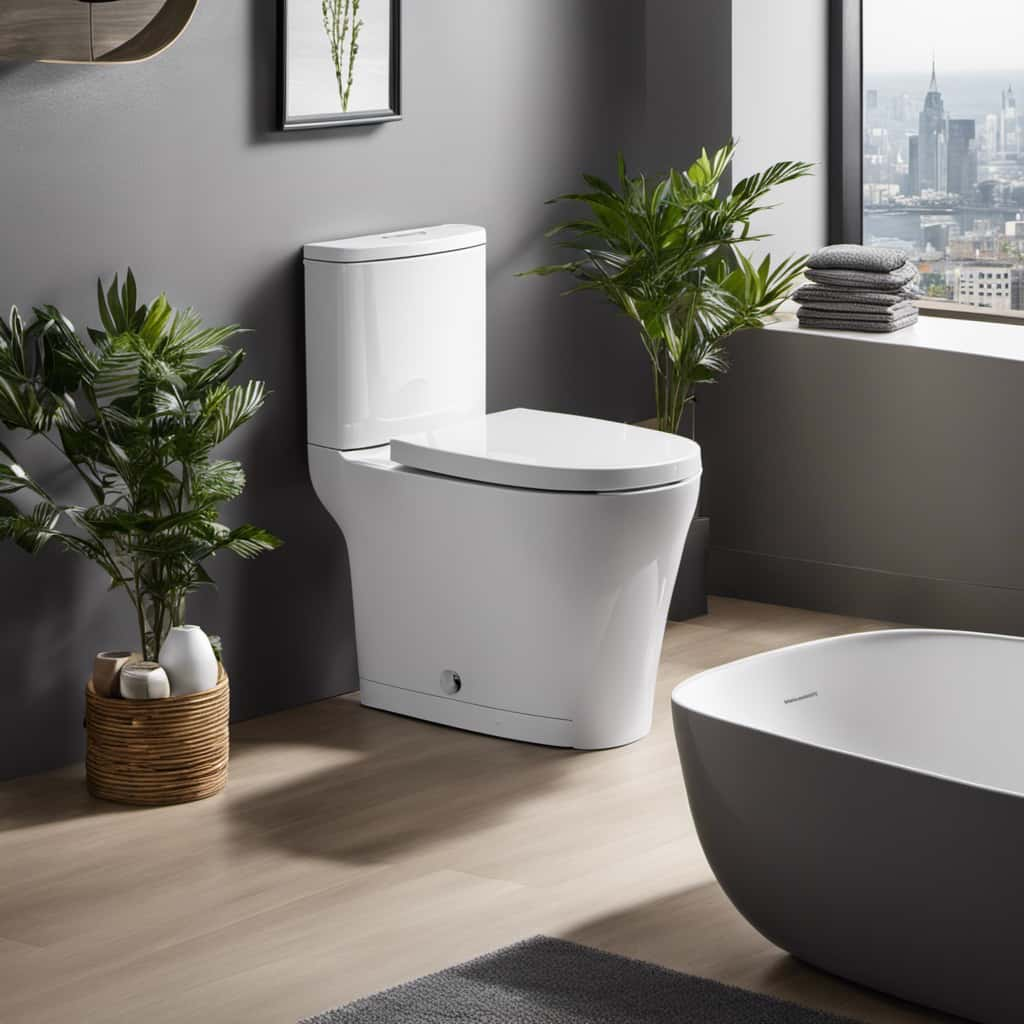
Now, let’s explore another method to improve toilet flush performance: using a plunger.
Use a Plunger
When it comes to unclogging a toilet, using a plunger is one of the most common and effective methods. Plungers work by creating suction and pressure to dislodge any blockages in the pipes.
It’s important to use the right technique and apply enough force for the plunger to work effectively.
Alternative Unclogging Methods
We prefer using a plunger as an alternative method for unclogging toilets. It’s a simple yet effective tool that can clear blockages by creating pressure and suction. Here are four reasons why using a plunger is a great choice:

- Versatility: A plunger can be used on different types of toilets, including low-flow and high-efficiency models.
- Cost-effective: Plungers are affordable and readily available at most hardware stores. They’re a cost-effective solution compared to hiring a professional plumber.
- Easy to use: Using a plunger requires minimal effort and no specialized skills. Simply place the rubber cup over the drain, create a seal, and push and pull to create pressure and suction.
- Quick results: In many cases, using a plunger can unclog a toilet within a few attempts. It’s a fast and efficient method that can save you time and frustration.
Preventive Maintenance Tips
For effective preventive maintenance, it’s essential to regularly incorporate the use of a plunger in our toilet maintenance routine. Using a plunger is a simple yet effective way to improve water flow and prevent clogs in our toilets.
When used correctly, a plunger creates pressure that dislodges any blockages in the pipes, allowing water to flow freely. To use a plunger properly, place it over the drain hole and push down firmly, then pull up quickly. Repeat this motion several times until the water starts draining smoothly. It’s important to ensure a tight seal between the plunger and the drain hole for maximum effectiveness.
Install a Toilet Auger
To improve the flushing performance of our toilet, one effective method is to install a toilet auger. A toilet auger, also known as a closet auger, is a specialized tool designed to clear stubborn clogs in the toilet trap or drain pipe. Here are four reasons why installing a toilet auger can be beneficial for troubleshooting toilet clogs:
- Effective clearing: A toilet auger has a flexible cable with a corkscrew-like end that can navigate through the twists and turns of the toilet drain, effectively removing any blockages.
- Versatile usage: Toilet augers can be used to clear both minor and major toilet clogs, making them a versatile tool for maintaining a properly functioning toilet.
- Jet cleaning tools: Some toilet augers come with additional features, such as jet cleaning tools, which help to blast away stubborn debris and buildup, ensuring a thorough cleaning of the toilet drain.
- Cost-effective solution: Installing a toilet auger can save you from costly plumbing bills. By being able to troubleshoot toilet clogs on your own, you can avoid unnecessary expenses and keep your toilet flushing smoothly.
Check the Water Pressure
First, let’s consider adjusting the water pressure as it can have a significant impact on the efficiency of a toilet flush. By ensuring that the water pressure is set at an optimal level, we can maximize the force of the flush and improve its effectiveness.
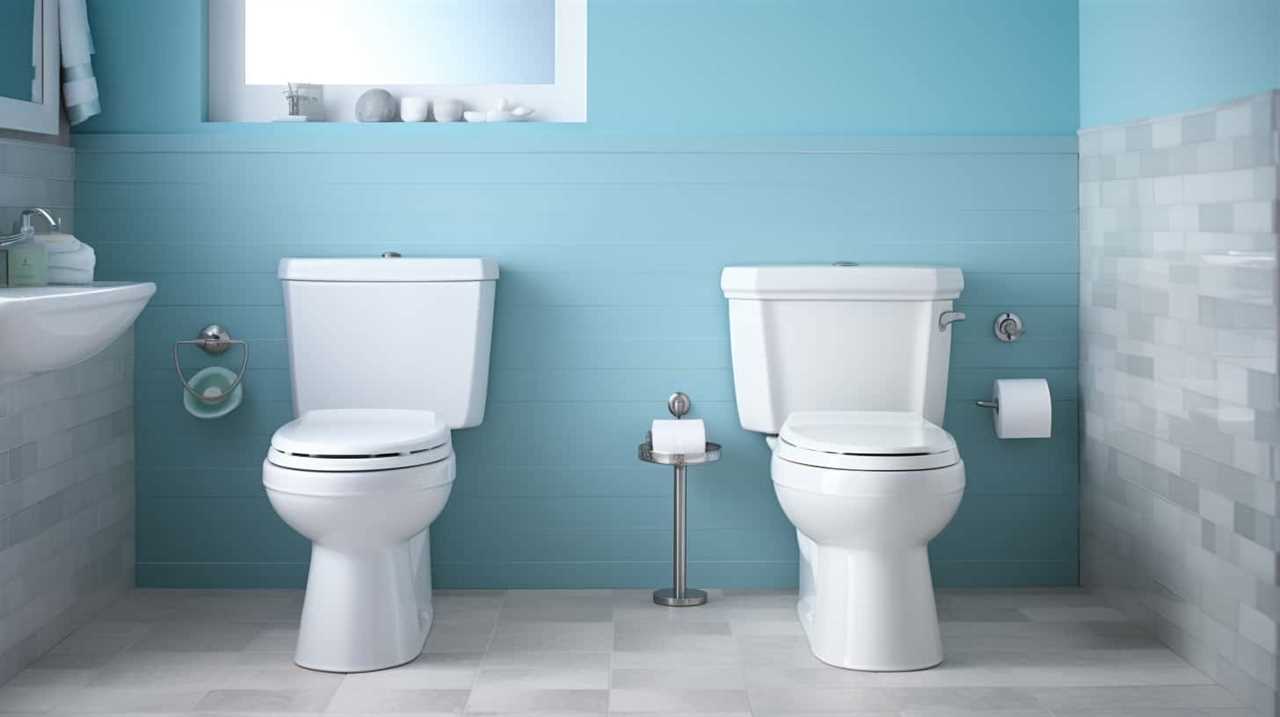
Additionally, troubleshooting low water pressure issues can help identify any underlying problems that may be affecting the flush performance.
Adjusting Water Pressure
We should start by checking the water pressure to determine if it needs adjustment in order to make the toilet flush better. Adjusting the water pressure can have a significant impact on the efficiency and effectiveness of the flush.
Here are four key points to consider when checking and adjusting the water pressure:
- Use a pressure gauge: Install a pressure gauge on a faucet or hose bib closest to the main water supply line. This gauge will help you measure the water pressure accurately.
- Ideal pressure range: The recommended water pressure for a toilet flush is between 20 to 50 pounds per square inch (psi). If the pressure is too low, it can cause weak flushes, while high pressure can lead to water wastage and potential damage to the toilet components.
- Adjusting the pressure regulator: If the pressure is too high, locate the pressure regulator valve and adjust it accordingly. This valve can usually be found near the main water supply line where it enters the house.
- Seek professional help if needed: If you’re unsure about adjusting the water pressure or if the pressure regulator valve needs repair, it’s best to consult a professional plumber for assistance.
Impact on Flush Efficiency
Checking the water pressure is essential to assess its impact on the efficiency of the flush. When it comes to improving water flow and maximizing flushing power, understanding the water pressure is crucial.

Water pressure refers to the force at which water is delivered through the plumbing system. Insufficient water pressure can lead to poor flushing performance, causing clogs and inefficient waste removal. On the other hand, excessive water pressure can damage the toilet components and waste water unnecessarily.
To determine the ideal water pressure for optimal flush efficiency, it’s recommended to consult a professional plumber or refer to the manufacturer’s guidelines. They can help adjust the water pressure to ensure the toilet operates at its highest efficiency, promoting effective waste removal and preventing unnecessary water waste.
Troubleshooting Low Pressure
To troubleshoot low pressure and ensure optimal flush efficiency, it’s important to assess the water pressure in your plumbing system. Here are four key steps to troubleshooting low pressure:
- Check for leaks: Start by inspecting all the pipes and connections in your plumbing system for any signs of leakage. Even a small leak can significantly reduce water pressure, affecting the flush performance of your toilet.
- Examine the water supply valve: Make sure the water supply valve to your toilet is fully open. Sometimes, it may have been accidentally closed, causing low water pressure.
- Inspect the fill valve: The fill valve controls the water flow into the toilet tank. If it isn’t functioning properly, it can lead to low water pressure. Check for any blockages, debris, or malfunctions in the fill valve.
- Check the flapper: A common issue that can cause low pressure is a faulty or worn out flapper. If the flapper isn’t sealing properly, it can result in water leakage and reduced water pressure.
Upgrade Your Toilet’s Flush Valve
One option for improving your toilet’s flush is to upgrade its flush valve. The flush valve is responsible for releasing water from the tank into the bowl, creating the necessary force to remove waste effectively. By upgrading to a high-performance flush valve, you can ensure a more powerful and efficient flush.
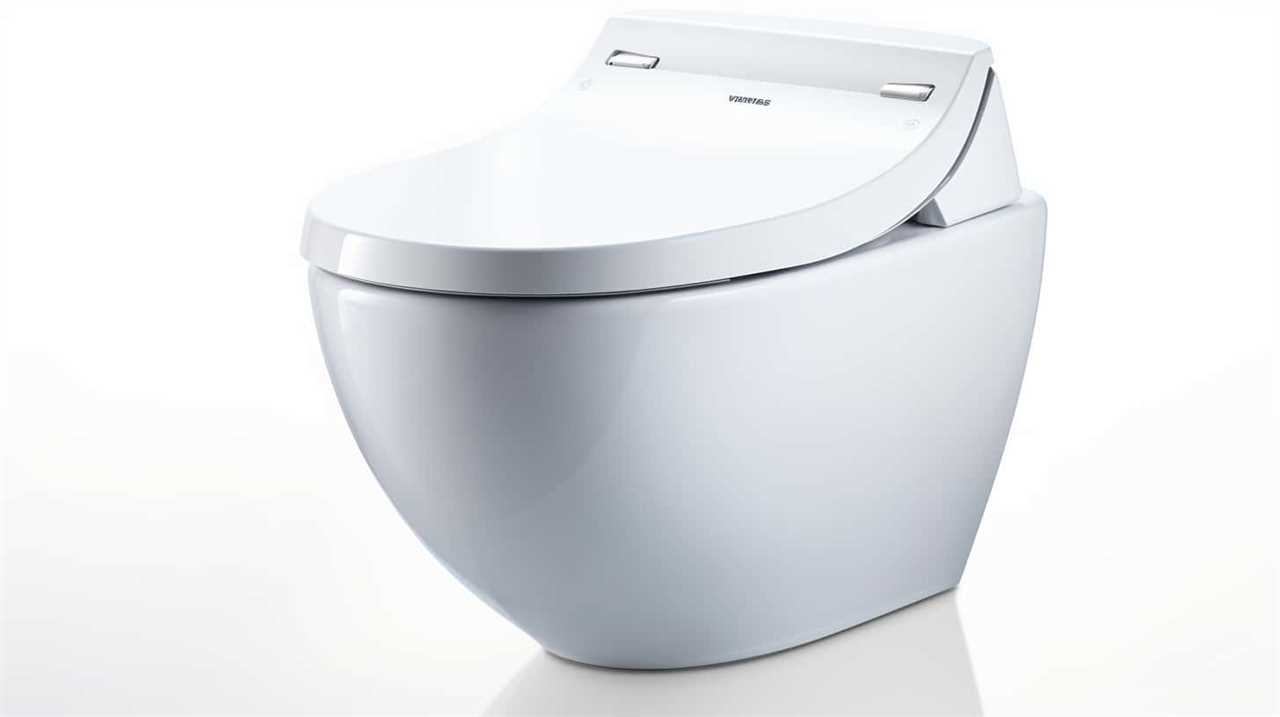
Consider the following table comparing different types of flush valves:
| Flush Valve Type | Description |
|---|---|
| Traditional | Standard valve found in most toilets. |
| Dual Flush | Provides two options for flushing: a lower volume for liquid waste and a higher volume for solid waste. |
| Pressure-Assisted | Uses air pressure to enhance the flushing power. Suitable for homes with frequent clogs. |
| Flapperless | Replaces the traditional flapper with a seal that releases water from the tank. Offers a quieter flush and reduces the risk of leaks. |
Upgrading your flush valve can significantly improve your toilet’s flushing performance. However, if you’re still experiencing issues, you may want to consider a dual flush system as the next step in optimizing your toilet’s efficiency.
Consider a Dual Flush System
We can enhance our toilet’s flushing performance by considering the installation of a dual flush system, which offers two options for flushing.
Here are four reasons why a dual flush system is beneficial:
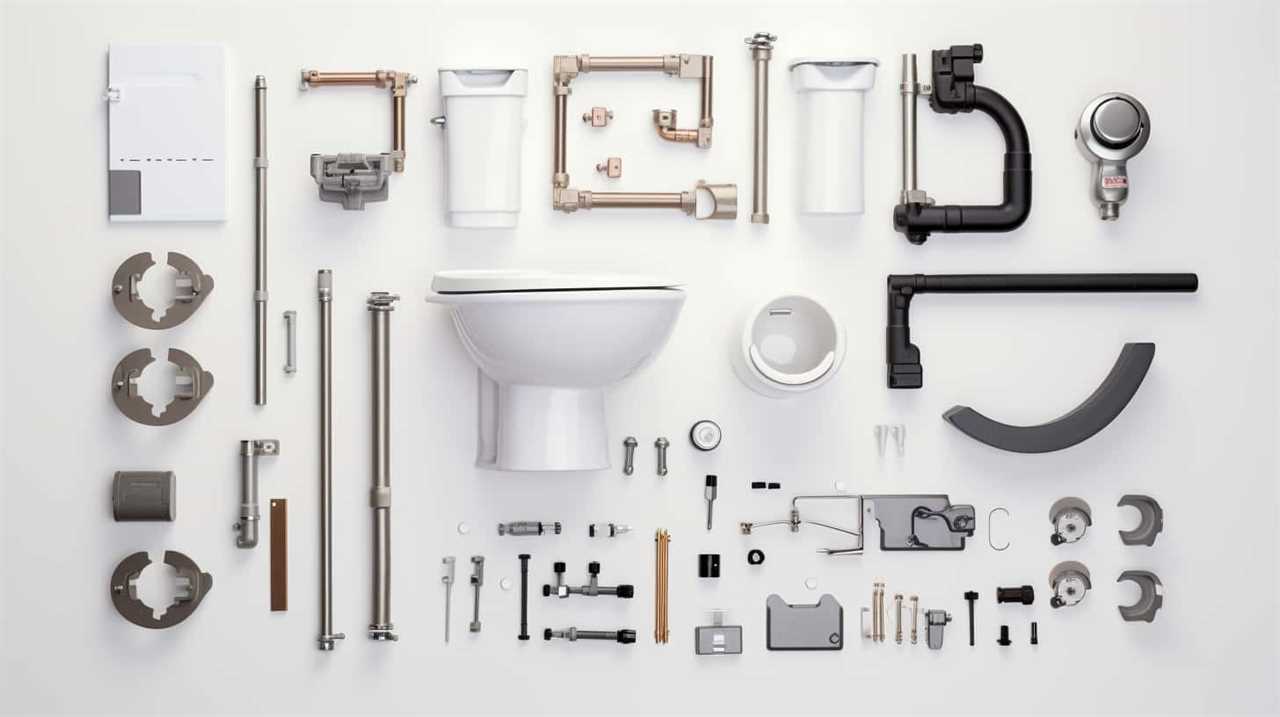
- Water Saving Options: One of the main benefits of a dual flush system is its ability to save water. With two flushing options – a full flush for solid waste and a half flush for liquid waste – you can choose the appropriate amount of water needed for each flush. This can lead to significant water savings over time.
- Environmental Impact: By conserving water, a dual flush system helps reduce the strain on natural resources and minimizes the environmental impact caused by excessive water consumption. It’s a simple yet effective way to contribute to water conservation efforts.
- Cost Savings: With a dual flush system, you’ll not only save water but also save money on your water bills. By using less water for each flush, you can lower your overall water usage and see a decrease in your monthly water expenses.
- Enhanced Flushing Performance: Dual flush systems are designed to provide better flushing performance compared to traditional flush systems. The two flush options allow for more efficient removal of waste, resulting in a cleaner and more hygienic toilet bowl.
Consider upgrading to a dual flush system to enjoy these benefits and make a positive impact on both the environment and your wallet.
Inspect the Fill Valve
Now let’s take a closer look at the fill valve to further improve our toilet’s flushing performance. The fill valve is responsible for refilling the toilet tank after each flush. Over time, it can become clogged with debris, affecting its functionality.
To ensure optimal performance, regular maintenance of the fill valve is essential. Start by turning off the water supply to the toilet and flushing to drain the tank. Inspect the fill valve for any signs of damage or wear. If everything looks intact, you can proceed with cleaning.
Using jet cleaning tools, such as a small brush or compressed air, carefully remove any debris or buildup from the valve. This will help restore its proper functioning. Remember to also check the water level adjustment and adjust if necessary.
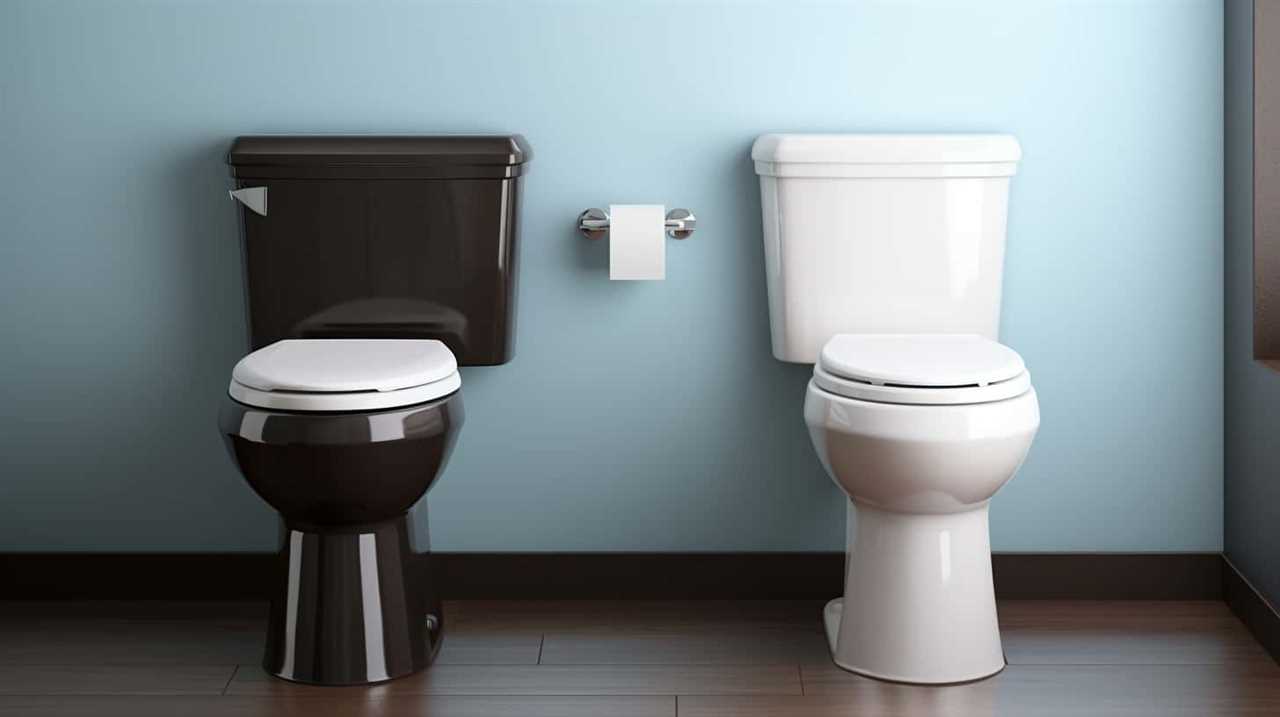
Now that we’ve inspected and cleaned the fill valve, let’s move on to the next area of focus.
However, if you encounter any difficulties or are unsure about the process, it’s always best to seek professional help.
Seek Professional Help if Needed
If we encounter any difficulties or are unsure about the process, it’s best to reach out for professional assistance. Seeking assistance from a professional plumber can help ensure that the toilet flush issue is resolved correctly and efficiently.
Here are four reasons why seeking professional help is essential:
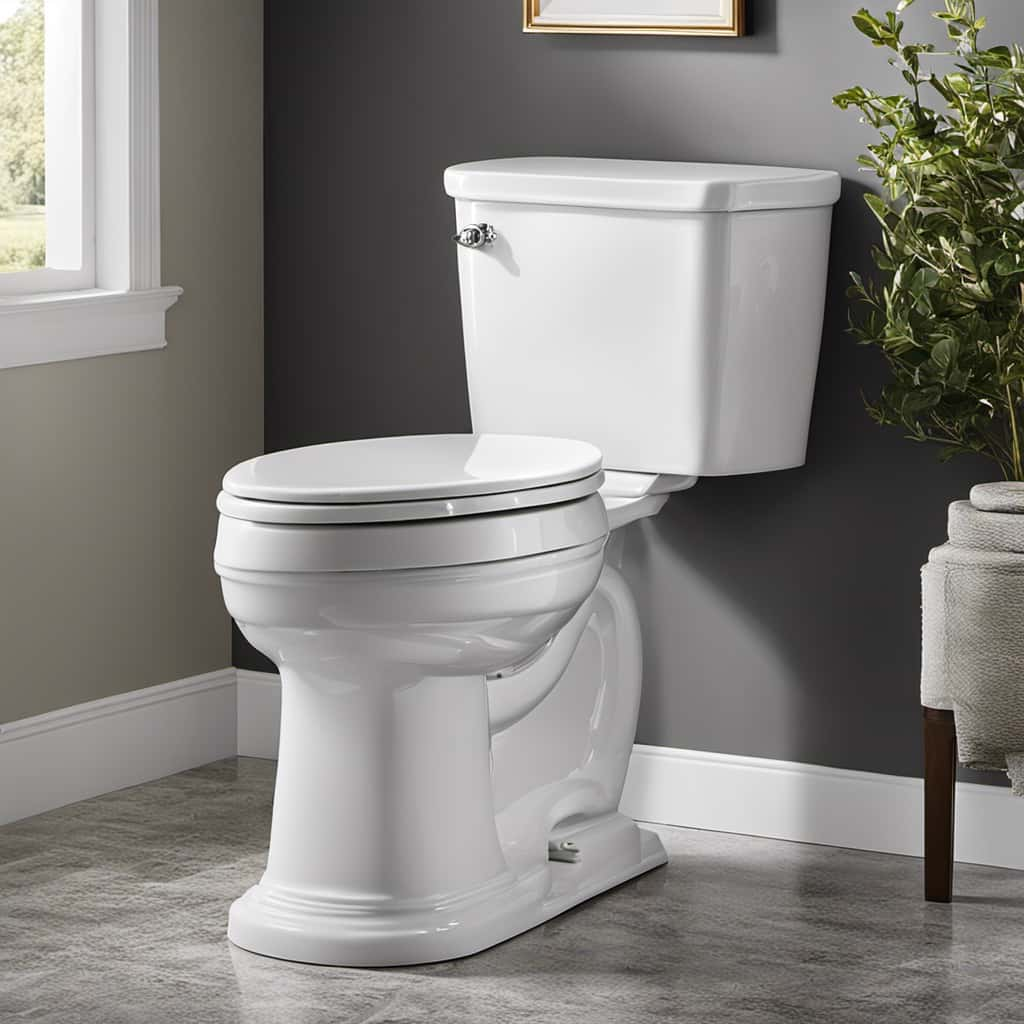
- Expertise: Professional plumbers have the necessary knowledge and experience to diagnose and fix complex toilet flushing problems effectively. They understand the intricacies of toilet systems and can provide accurate solutions.
- Troubleshooting Techniques: Plumbers are skilled in troubleshooting various toilet issues, including clogged pipes, faulty fill valves, or inadequate water pressure. They use advanced tools and techniques to identify the root cause of the problem.
- Time and Cost Savings: Hiring a professional plumber can save you time and money in the long run. They can quickly identify the problem, offer efficient solutions, and prevent further damage or costly repairs.
- Safety: Plumbing work can involve handling water and electrical components. Professional plumbers are trained to follow safety protocols and ensure that the repairs are done correctly, minimizing the risk of accidents or injuries.
Frequently Asked Questions
How Do I Check the Water Level in My Toilet?
To check the water level in your toilet, simply remove the tank lid and observe the water level. If it’s too high or too low, it could be causing issues like a running toilet. Refer to guides on how to fix a running toilet and replace a toilet flapper.
Why Is It Important to Adjust the Flapper Chain?
Adjusting the flapper chain is important to ensure proper flushing. Common mistakes include having the chain too loose or too tight, causing incomplete or continuous flushes. Expertise in adjusting the chain leads to optimal flushing performance.
How Can I Clean the Jets in My Toilet?
To clean the jets in our toilet, we can use specialized cleaning products designed for toilet jet maintenance. This ensures optimal performance and prevents clogs. Regular cleaning is key to maintaining a high-functioning toilet system.
When Should I Use a Plunger to Improve the Flush?
When improving water pressure or fixing clogged pipes, using a plunger can be effective. It creates suction, dislodging any blockages and allowing water to flow freely. Using a plunger should be considered if experiencing flush issues.
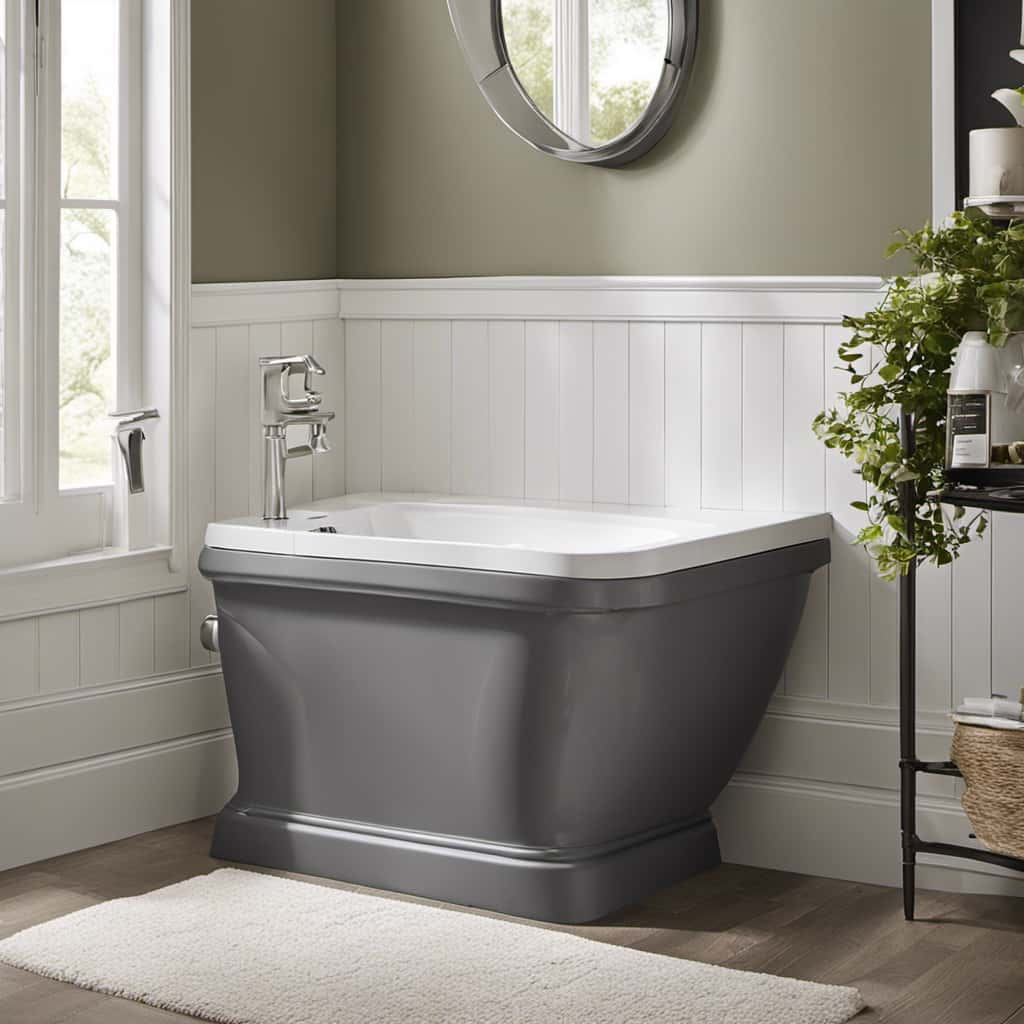
What Is a Toilet Auger and How Can It Help With a Better Flush?
Using a toilet auger can greatly improve your flush. This tool helps unclog stubborn blockages deep in the drain, ensuring a smoother flow of water. Its benefits are invaluable for troubleshooting toilet flush issues.
Conclusion
In conclusion, by following these simple steps, you can significantly improve the flushing performance of your toilet.
Remember to regularly check the water level, adjust the flapper chain, clean the jets, and use a plunger if necessary.
Consider upgrading your toilet’s flush valve or installing a dual flush system for even better results.
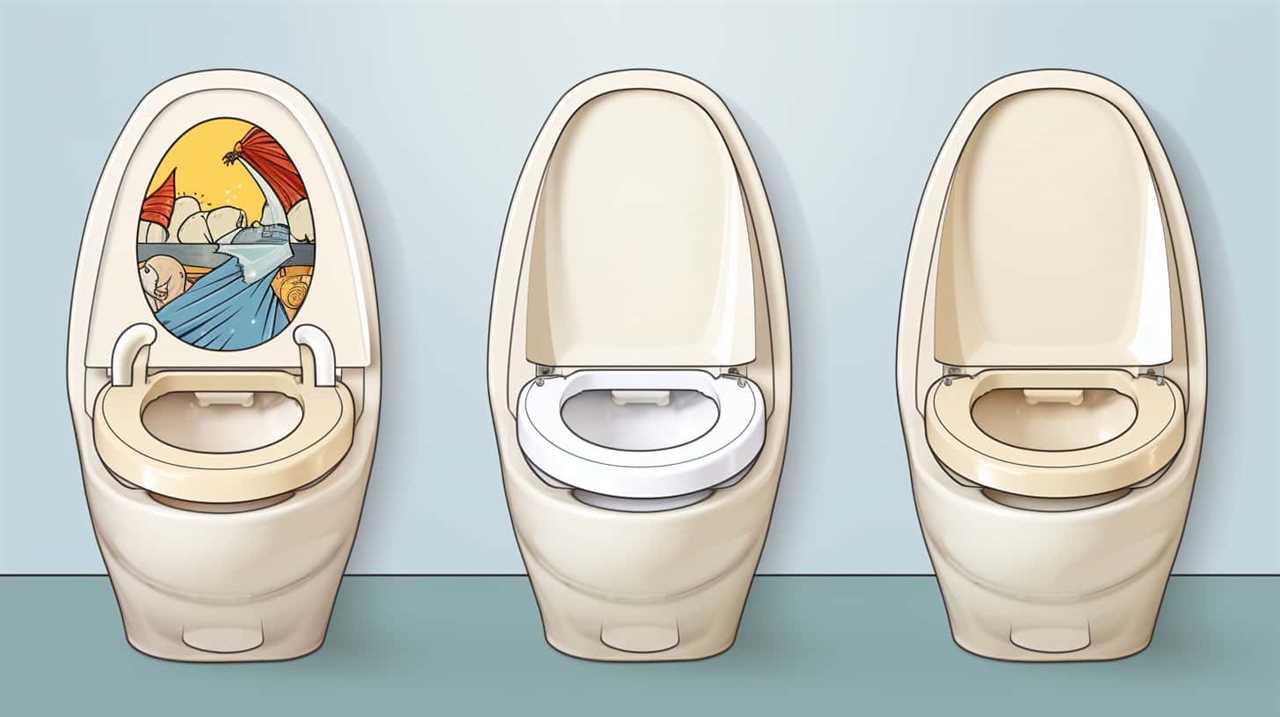
And don’t forget to inspect the fill valve for any issues.
If all else fails, don’t hesitate to seek professional help.
With these tips, you’ll have a toilet that flushes like a dream in no time.

